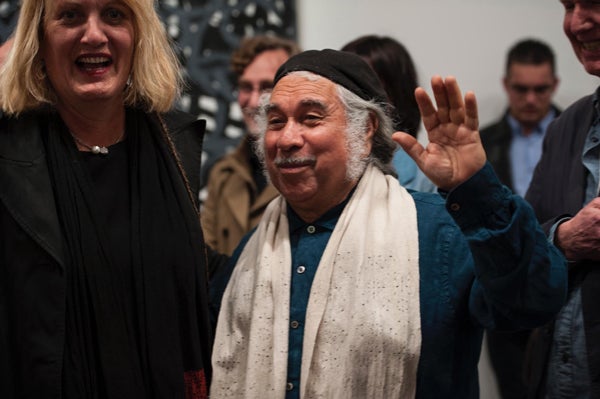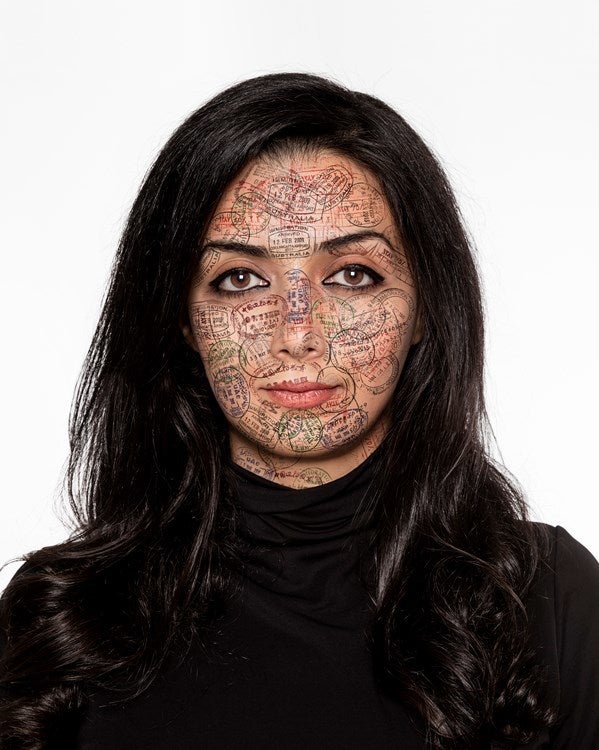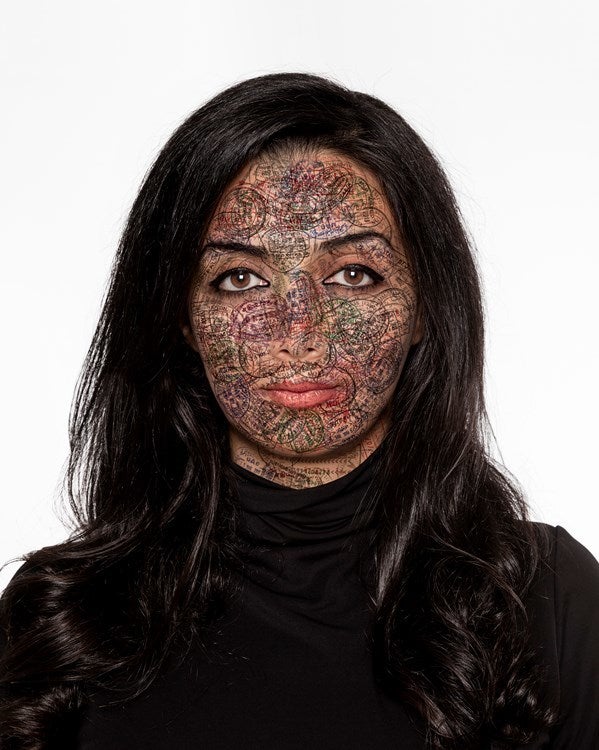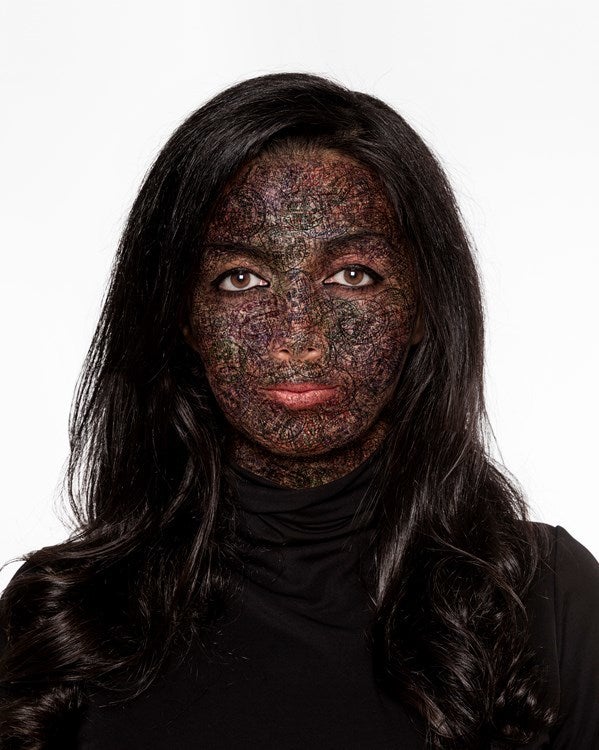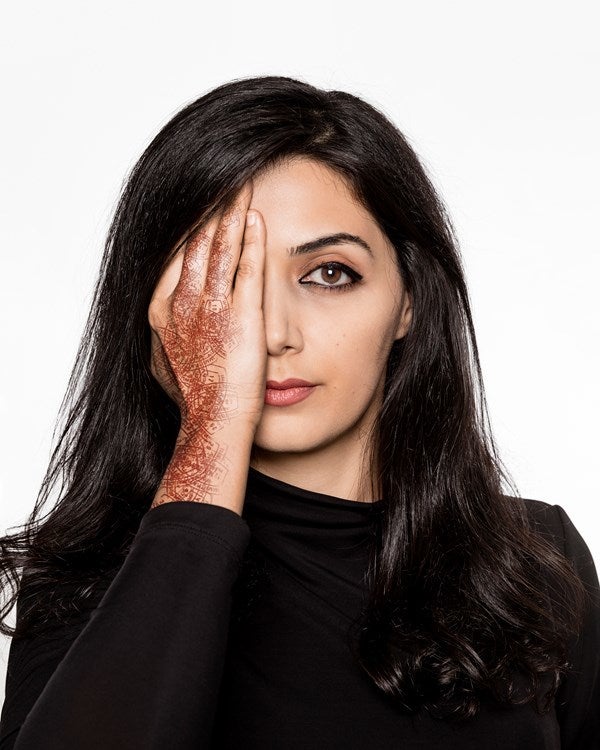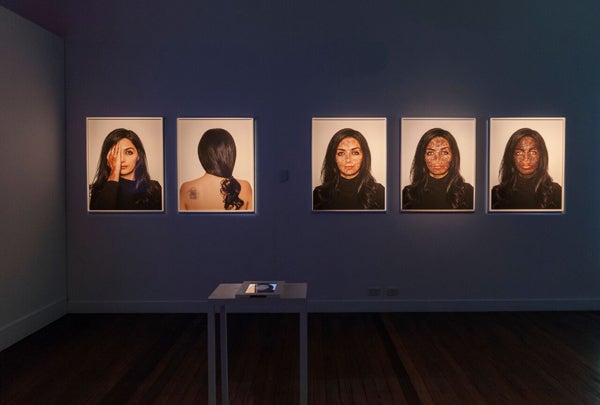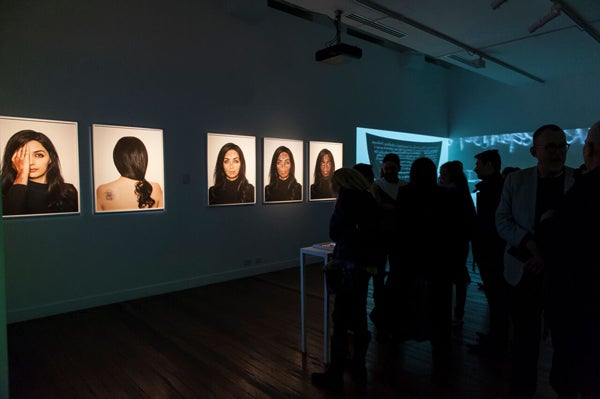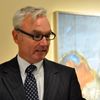In his Dadaist poem Anna Blume, Kurt Schwitters proclaims that the eponymous fraulein is the beloved of his 27 senses. Presumably he experiences her in ways we can only imagine. Sixth Sense, guest-curated by Djon Mundine for the National Art School Gallery, explores how cross-generational Aboriginal, Torres Strait Islander and non-Aboriginal artists perceive their world in ways that extend beyond the visual component of their otherwise visual art.
Artists in the exhibition are Daniel Boyd, Destiny Deacon and Virginia Fraser, Karla Dickens, Fiona Foley, Nicole Foreshew, Willurai Kirkbright, Emily Kame Kngwarreye, Gabriella Mangano and Silvana Mangano, Archie Moore, Nasim Nasr and Skye Raabe. Their media includes sound, video, installation, photomedia, and painting.
Below is an email interview conducted with Mr. Mundine, Judith Blackall, Curator at the National Art School Gallery, and one of the artists in the show, Nasim Nasr.
DJON MUNDINE/JUDITH BLACKALL
JS: What prompted the exhibition and how did you choose the respective artists? Is it an extension of your prior curatorial efforts? Does it respond to any recent exhibitions?
DM: I have worked with all of these artists on other projects. Eight were included in an exhibition I co-curated for the Tarrawarra Biennale of Art in 2014 titled Whisper in my Mask. Nasim was one of the artists in that exhibition, along with Daniel Boyd, Destiny Deacon and Virginia Fraser, Karla Dickens, Fiona Foley, Gabriella Mangano and Silvana Mangano. For Sixth Sense I decided to invite this group of artists, some with the same work and others with more recent pieces, which haven’t been seen in Sydney. I augmented the selection with other artists whose work suits the concept. It’s been a positive project for the artists – many have made new work for the exhibition. As a group of artists, their approaches are diverse, they span generations, race, cultures and gender. They share aspects of the spiritual and incorporate elements of the senses in their artwork. In many ways I work with a certain group of artists over and over, add new artists and leave others out – almost like an avant-garde theater company of players who collaborate to the central idea or concept of the exhibition. So this array of artists and art pieces are re-born and renewed in this particular context. The work travels across the line from nonsense to sense – a form of imagination, traumatic or tortured colonial experience into a sixth sense of emotion and affect.
JS: Your exhibition investigates sensory experience, perception and/or intuition. Why, a hundred years or so after Malevich, Kandinsky, and Mondrian, is this a significant focus in contemporary art?
DM: Australian society struggles with a collective guilt – an arm-wrestle with a form of ‘a creature from the id’ both in the crimes wrapped in colonial history and a lack of restraint on the freedom of a new society full of possibilities. The artists mentioned above lived in a felt time of social change – Aboriginal people and Australian society in a deep time of power adjustment and increasing awareness of financial and social differences across race, gender, and class lines. Art and artists are always capable of seeing the world differently, and their work is able to move people in different ways. I think this is especially true of Aboriginal artists who are widely believed to have an intuitive sixth sense, in fact many artists are thought to possess a ‘sixth sense’. It is something pre-renaissance, pre-rationalist, beyond the usually considered ‘five senses’; sight, sound, taste, touch and smell. The artists in this exhibition all deal with a range of senses, not just visual. For example, the paintings of the late Emily Kame Kngwarreye in Aboriginal terms are sensed as song, dance movement, taste and scent rather than static visual images. These days there are other senses – such as equilibrioception (sense of balance) and proprioception (sense of body position, or kineosphere) – that are recognised physiological senses.
JS: In his Art in the Age of Mechanical Reproduction, Walter Benjamin discusses the idea of the loss of art’s aura as a result of photography and motion pictures. Does your exhibition respond to the virtual world of, say, computer gaming?
DM: While there are a number of works using projected imagery, digital video, in this project I have steered more towards work that engages with personal histories and social frameworks, and other factors influence our senses and responses. The artists tend to use more tangible materials – if anything they lean toward the politics and poetics of arte povera. I am interested in artists whose work puts the aura back into art. Contemporary society increasingly leads us into a world of simulacra, away from the etymological meaning of ‘sensible’ – perceptible by the senses. We often think of the spiritual as a light, but can it not also be a smell, a taste or a touch? The meaning of sensory experience is mediated through social structures and sieves – Aboriginal and colonial that collide and wash up in waves against each other.
JS: In his same essay, Benjamin continues that the loss of aura is not necessarily a bad thing because it could lead to the politicization of art. Would you say, in one or another, that the work is political? If yes, how?
JB: A number of the works in this exhibition are very political. The lives and personal experiences of the artists are influenced by political realities. Nasim Nasr is an artist who was born in Iran, and as a woman, she found it very difficult to freely pursue her artwork there. After an incident when her works were removed by officials from the gallery just hours before an opening, Nasr decided she could not stay in Iran and she emigrated to Australia. Now living in Sydney, Nasr’s work comments upon specific personal experiences and universal cultural concerns in society. Her photography and video practice engages complex issues of state and self-censorship, the transience of cultural and personal identity, and global concerns of civil, social and political unrest. Her new photographic series Forty Pages (2016) contemplates personal identity in the context of movement from one culture to another, referring to the forty pages in the Iranian passport and the notebook in Iranian primary school known as ‘forty pages’. Self-identification, or actualisation, is a sense we must constantly state and maintain, against the often Kafkaesque indifference and insensitive ‘official’ stereotyping or prejudices that threaten to assimilate and obliterate us.
DM: Inanimate objects, art designated or otherwise, have meaning though social action and practice, and no more so than here.
JS: What was your biggest challenge in mounting the exhibition?
JB: Bringing some of the larger scale works into the gallery and sourcing 133 pounds of honey!
A number of the works have very evocative sound, and in a group exhibition it’s a challenge to ensure individual artwork can be heard distinctly. Inevitably there is some sound spill across the space, especially as the National Art School Gallery is located in a historical site: in the 1800s it was Sydney’s first large jail. Built of locally quarried Sydney sandstone, it is one of Sydney’s colonial sites and well-preserved original architecture. It was converted and opened as an educational institution in 1922, but it still retains its colonial architecture – elegant and perfect for contemporary art, but it’s hard to contain the acoustics.
Returning to your point about political content in the exhibition, Daniel Boyd works with dots and he’s made a new work specifically for the gallery’s soaring window. Boyd’s dotted work is a metaphor for focus and ways to view both the historic and contemporary world and the imagery bombarding us every day. He has made two new paintings – very poignant work that refers specifically to the incarceration of a young Aboriginal man named Jimmy Governor (1875-1901) who grew up between white and black cultures. He was imprisoned in Darlinghurst jail for murder and was hanged there in 1901. Thomas Keneally wrote Jimmy Governor’s story in The Chant of Jimmy Blacksmith, later made into a film by Fred Schepisi. Boyd’s evocative portraits are drawn from the jail photographs of Governor, who was only 26 when he met his end. There are a great many young Aboriginal and Torres Strait Islander men and women held in Australian prisons. They are massively overrepresented in the criminal justice system of Australia. Aboriginal people represent only 3% of the total population, yet more than 28% of Australia’s prison population are Aboriginal.
DM: Beyond the practical and ever-present problems of funding, and space arrangement; the window dressing, was most probably the Monty Pythonesque ‘state’ political background where whether the NAS would continue to exist or not was a serious distraction.
JS: What’s the one walkaway impression you’d want exhibition visitors to have?
DM: I think all art is a political art and directly more-so in the Aboriginal-colonial context. That we persist and remain vocaI and visible would, l feel, make the exhibition a success if visitors have been stimulated to think on their emotional responses.
JB: A meaningful and thought-provoking experience, and the desire to be more generous toward the other.
JS: Since this interview includes Nasim Nasr, what specifically drew you to her work?
DM: Her work goes to the heart of all art creative practice; to ‘talk’ through all means possible, and in this action describing simple positive, every day, universal personal actions.
NASIM NASR
JS: Your contribution to the exhibition, Forty Pages, refers to the forty pages in a passport. That’s a fantastic starting point! How did you come up with the idea?
NN: I remember when I was a child at school our schoolbooks had forty pages to them. And coincidentally there are forty pages in an Iranian passport. When I was considering the initial idea for this series I was of course focusing on my passport and all the travel experiences associated with that—gaining visas, the varying degrees of difficulty (or not) entering numerous countries, and the various feelings of disempowerment and subjugation felt during both of those processes. Moving from culture to culture, country to country, presents multiple challenges. So while contemplating this reality my mind reverted to when I was a girl at school, and the coincidence of forty pages in our schoolbook—quite an interesting realization when you consider the significance of both objects.
JS: Would you please describe how you put the piece together? What went into the various images?
NN: The photographs were done to look like real passport photos—non-smiling, face-on toward the camera, head and shoulders etc., as is required by all countries. Stamps were scanned from my Iranian passport, of entering and exiting Australia, and other countries during my artistic travels. These stamps, in differing colours of the various countries I have visited, were then layered over the top of each other. First several stamps in one portrait, then rapidly overlaid until in the third portrait my face is effectively black with so many stamps. In portrait number five these stamps are henna coloured and ‘travel’ so to speak up my arm as one would have a henna pattern on their hands and fingers in the Middle East. The subsequent artworks are both large, 100cm high and at real passport size, about 5cm high.
JS: How does this continue your prior bodies of work?
NN: My photography and video practice explores and comments upon both specific and universal cultural concerns in contemporary society. It engages complex issues of State and self-censorship, the transience of cultural and personal identity, and global concerns of civil, social and political unrest.
JS: One aspect of your work studies the difficult task of reconstructing or else maintaining an identity as you move from one distinct culture (Iran) to an entirely different one (Australia.) How has this cultural clash impacted both this piece and your personal life? Or, are the two co-joined?
NN: I am interested in the notion of cultural relationships and their role in western and eastern contemporary society. My artwork articulates the complexities of cultural difference, as experienced between my past and present homelands. To me it doesn’t meet but it also doesn’t clash. It is sometimes completing each other at some point. The depth and historical element of the Middle East and emotional, spiritual part can easily complete the constructive, organized West.
The show runs until October 15. Gallery hours are 11 AM – 5 PM, Monday through Saturday. The gallery is located at National Art School Forbes Street and Burton Street, Darlinghurst NSW 2010, Sydney, Australia. For more information, click here.
